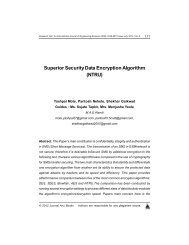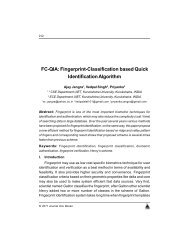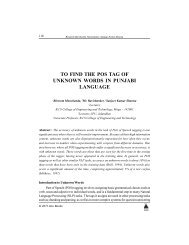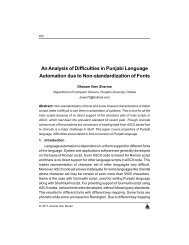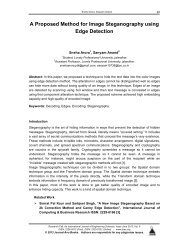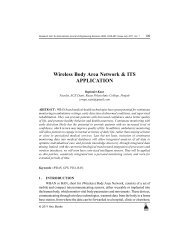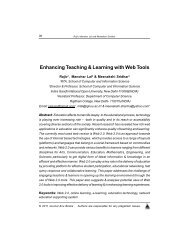Comparison and Implementation of Audio based ... - Ijoes.org
Comparison and Implementation of Audio based ... - Ijoes.org
Comparison and Implementation of Audio based ... - Ijoes.org
Create successful ePaper yourself
Turn your PDF publications into a flip-book with our unique Google optimized e-Paper software.
244<br />
<strong>Comparison</strong> <strong>and</strong> <strong>Implementation</strong> <strong>of</strong> <strong>Audio</strong> <strong>based</strong><br />
Searching for Indian Classical Music<br />
Akshat Arora, Nikhil Panwar, Pankaj Sikka<br />
Jaypee Institute <strong>of</strong> Information Technology, Noida<br />
akshatarora13@gmail.com, nikhilrajput4u@gmail.com,<br />
sikka.pankaj@yahoo.co.in<br />
Abstract: Increase in the amount <strong>of</strong> digital audio media in recent years, dem<strong>and</strong>s<br />
for content <strong>based</strong> retrieval <strong>of</strong> multimedia. However India classical Music is untouched<br />
from this revolution. Hence, this paper presents a comparative study on content<br />
<strong>based</strong> identification <strong>and</strong> retrieval for Indian Classical Music. The paper focuses on<br />
comparative implementation <strong>of</strong> various features like mfcc, bark scale <strong>based</strong> features<br />
etc for reliable, fast <strong>and</strong> robust identification <strong>of</strong> Indian classical music which can be<br />
run on the resources provided by today’s st<strong>and</strong>ard computing platforms. Besides, a<br />
new modified feature has also been proposed to minimize the drawbacks (i.e. space<br />
<strong>and</strong> time complexity) <strong>of</strong> already existing features. The algorithms are tested on Indian<br />
Classical Music, which exhibits certain characteristics that make the identification<br />
task harder when compared to Western music.<br />
Keywords: Content <strong>based</strong> audio retrieval, Indian classical Music, <strong>Audio</strong> Fingerprinting,<br />
MFCC, FFT<br />
1. Introduction<br />
The exponential growth <strong>of</strong> the Internet <strong>and</strong> compression technologies has made<br />
huge amounts <strong>of</strong> audio data easily available. This, in turn has spurred the growth <strong>of</strong><br />
multimedia databases spanning in diverse fields such as arts, medicine, music,<br />
science, engineering. However currently, retrieval <strong>and</strong> management <strong>of</strong> audio data<br />
rely mostly on textual information which is added by human/user, which is an<br />
© 2011 Journal Anu Books
Research Cell: An International Journal <strong>of</strong> Engineering Sciences ISSN: 2229-6913 Issue Sept 2011, Vol. 4<br />
245<br />
extremely inaccurate task <strong>and</strong> furthermore, this information is <strong>of</strong>ten incomplete or<br />
not available at all. Hence to retrieve the information from database is an extremely<br />
arduous task thereby hampering the growth <strong>of</strong> fields such as Indian Classical Music.<br />
However search <strong>based</strong> on actual content rather than on the keywords associated<br />
with it can provide the much needed impetus to it. Efficient <strong>and</strong> accurate automatic<br />
music information processing (accessing <strong>and</strong> retrieval, in particular) will be an<br />
extremely important issue in the coming future. This is why automatic systems are<br />
required to lighten the job.<br />
The retrieval function used is query by example which aims at automatic retrieval<br />
<strong>of</strong> audio excerpts similar to a user provided audio sample from his/her personal audio<br />
database. In the query by example approach the user provides an example <strong>of</strong> an<br />
audio signal <strong>and</strong> <strong>based</strong> on that example, similar samples are retrieved from the<br />
database. The retrieval is <strong>based</strong> on some similarity measure between the example<br />
<strong>and</strong> database samples. There are other ways <strong>of</strong> querying audio data e.g. by audio<br />
features like pitch or words/text. Query by example [1] [2] is most convenient for a<br />
user <strong>and</strong> is <strong>of</strong>ten also a relatively accurate way <strong>of</strong> specifying the information needed.<br />
Although audio information retrieval has been enjoying a great amount <strong>of</strong> attention,<br />
Indian classical music is yet to be impacted by the influence <strong>of</strong> computer <strong>based</strong><br />
automation tools. Indian Classical Music deserves special attention as it is different<br />
from western music in many aspects. Western music <strong>and</strong> instruments are <strong>based</strong> on<br />
equal tempered scale which is not the case with Indian music <strong>and</strong> instruments.<br />
Indian Classical music is <strong>based</strong> on a scale which is not tempered [3]. Western<br />
music divides an octave into the twelve notes <strong>of</strong> the chromatic scale, Indian Classical<br />
music does the same but the notes are not tuned like the notes <strong>of</strong> the chromatic<br />
scale. Another significant difference is that Western Music is polyphonic i.e. it depends<br />
on the resonance <strong>of</strong> multiple musical notes occurring together but Indian Classical<br />
music is essentially monophonic.<br />
In this paper, Fingerprinting algorithms have been implemented <strong>and</strong> tested on a<br />
database containing various forms <strong>of</strong> Indian Classical Music (Dhrupad, Thumri, Dhamar,<br />
Ragas etc). An audio fingerprint basically summaries <strong>and</strong> differentiates each <strong>and</strong><br />
every audio clip from the others as in the case <strong>of</strong> human fingerprinting. All the<br />
algorithms under consideration are <strong>based</strong> on frame <strong>based</strong> features [4][5] i.e. a long<br />
audio clip is divided into many frames to catch the short time property, but the<br />
features extracted are absolutely different.<br />
© 2011 Journal Anu Books
246<br />
Akshat Arora, Nikhil Panwar, Pankaj Sikka<br />
2. Algorithm Overview<br />
In spite <strong>of</strong> the different justifications behind various identification tasks, retrieval<br />
methods share certain aspects. As depicted in Fig.1, there are three fundamental<br />
processes: pre-processing, feature extraction, <strong>and</strong> matching algorithm. Fig 2 shows<br />
the process <strong>of</strong> fingerprint extraction which is further explained in the next section.<br />
Efficient features must be derived for robust identification <strong>and</strong> retrievals. The feature<br />
requirements include discrimination power over huge numbers <strong>of</strong> other features,<br />
invariance to distortions, compactness, <strong>and</strong> computational simplicity. Robust features<br />
must fulfill the above requirements <strong>and</strong> therefore imply a trade-<strong>of</strong>f between<br />
dimensionality reduction <strong>and</strong> information loss. After the pre-processing is achieved,<br />
the feature vectors are calculated for both, i.e. the example signal from the user, <strong>and</strong><br />
for the database signal. One by one each database signal is compared to the example<br />
signal. If similarity criterion is fulfilled, the database sample is retrieved [6]. According<br />
to [7], efficient searching methods should be fast, correct <strong>and</strong> memory efficient. The<br />
matching algorithm actually implemented fulfilled most <strong>of</strong> these conditions.<br />
Fig. 1 a block diagram <strong>of</strong> the overall system<br />
3. Pre- Processing<br />
As shown in Fig 2, the audio needs to be digitalized in this first step. This has<br />
been achieved by using DirectX 9.0 library. In some cases, audio was down sampled.<br />
But no such changes were done when MFCC <strong>and</strong> new 4-bit fingerprint were used for<br />
matching audio documents <strong>and</strong> the sampling rate was maintained at default 44.1<br />
KHz. Although, bark scale <strong>based</strong> features were found to be working better when the<br />
audio samples were down sampled to 5 KHz.<br />
© 2011 Journal Anu Books
Research Cell: An International Journal <strong>of</strong> Engineering Sciences ISSN: 2229-6913 Issue Sept 2011, Vol. 4<br />
247<br />
4. Framing <strong>and</strong> Overlap<br />
In audio retrieval, frame-<strong>based</strong> representation is instinctive because audio frame<br />
is the basic composition. The audio signal can be regarded as stationary over an<br />
interval <strong>of</strong> a few milliseconds (i.e. quasi-stationary). Hence, short-time spectral analysis<br />
<strong>of</strong> audio signals is the most preferred way to classify them. The signal has been<br />
divided into frames <strong>of</strong> a size equivalent to the variable velocity <strong>of</strong> the underlying<br />
auditory events. This step also includes application <strong>of</strong> window function to frames.<br />
The main aim <strong>of</strong> applying window function to each individual frame is to minimize the<br />
signal discontinuities at the beginning <strong>and</strong> end <strong>of</strong> each frame. The concept here is<br />
to minimize the spectral distortion by using the window to taper the signal to zero at<br />
the beginning <strong>and</strong> end <strong>of</strong> each frame. Overlap must be applied to mitigate the loss at<br />
the edges <strong>of</strong> the window. Typically, Hamming window has been used in all the feature<br />
extraction algorithms which have the form:<br />
Hamming window time <strong>and</strong> frequency domain mapping<br />
W (n) = 0.53836 – 0.46164 cos (2πn/N-1) (1)<br />
N = No. <strong>of</strong> samples in a frame<br />
n = Sample no. in the frame<br />
Choosing the right frame size <strong>and</strong> overlap factor is always an important issue as<br />
it decides the robustness <strong>and</strong> time complexity to a large extent. Bark scale <strong>based</strong><br />
32 bit fingerprint features were found to give best results when the frame size was<br />
2048 samples <strong>and</strong> the hop size was as low as 1/32 to ensure accurate results even<br />
in worst case scenarios.<br />
© 2011 Journal Anu Books
248<br />
Akshat Arora, Nikhil Panwar, Pankaj Sikka<br />
The new, modified 4 bit fingerprint feature, used the same frame size i.e. 2048 samples<br />
but the overlap factor in this case was reduced to 15/16, thus decreasing the number<br />
<strong>of</strong> frames, <strong>and</strong> hence improving the time taken in the feature calculation process.<br />
MFCC worked efficiently when frame size was reduced to 512 samples with a hop<br />
size <strong>of</strong> 256 frames.<br />
Fig 2: Fingerprint Extraction Framework<br />
5. Spectral Estimates <strong>and</strong> Feature Extraction<br />
As shown in Fig 2, transformations are applied on the time representation <strong>of</strong><br />
audio document to extract the auditory vectors. The aim is again to reduce the<br />
complexity <strong>and</strong>, at the same time, to increase the resistance to noise.<br />
For the transformation FFT [8] has been computed on the frames for all the algorithms<br />
to represent the signal on the time frequency scale. This paper focuses on <strong>Audio</strong><br />
fingerprinting techniques which function by extracting features <strong>of</strong> audio files <strong>and</strong><br />
storing them in database. To calculate robust features, knowledge <strong>of</strong> the transduction<br />
phases <strong>of</strong> the human auditory system has been incorporated. The acoustic features<br />
evaluated in this paper are as follows:<br />
Mell Frequency Cesptral Coefficients<br />
For calculating the MFCC[9] mel-frequency scale is defined, which is a linear<br />
frequency spacing below 1000 Hz <strong>and</strong> a logarithmic spacing above 1000 Hz . As a<br />
© 2011 Journal Anu Books
Research Cell: An International Journal <strong>of</strong> Engineering Sciences ISSN: 2229-6913 Issue Sept 2011, Vol. 4<br />
249<br />
reference, 1000 Mels is defined as the pitch <strong>of</strong> a 1 kHz tone, 40 dB above the<br />
noncognitive hearing threshold. In order to capture the phonetically important<br />
characteristics <strong>of</strong> audio clip filters spaced linearly at low frequencies <strong>and</strong><br />
logarithmically at high frequencies have been used Therefore we can use the following<br />
approximate formula to compute the mels for a given frequency f in Hz:<br />
Mel (f) =2595* log (1+ f/700) (2)<br />
Thus for each tone with an actual frequency, f, measured in Hz, a subjective<br />
pitch is measured on the mel scale.<br />
Now the log mel spectrum in frequency domain are converted back to time<br />
domain which is called the mel frequency cepstrum coefficients (MFCC) as cepstral<br />
representation provides a descriptive representation <strong>of</strong> the local spectral properties<br />
<strong>of</strong> the audio signal for the given frame analysis. Because the Mel spectrum coefficients<br />
(<strong>and</strong> so their logarithm) are real numbers, we can convert them to the time domain<br />
using the Inverse Fourier Transformation.<br />
Fig. 4: <strong>Audio</strong> parameterization into mel frequency cepstral coefficients<br />
Bark Scale <strong>based</strong> Feature<br />
This feature is <strong>based</strong> on the energies <strong>of</strong> 33 bark scaled features as proposed by<br />
Haitsma et al [10]. The feature proposed by Haitsma has been modified to reduce its<br />
time complexity <strong>and</strong> make it more accurate (Fig 5). Relevant 32 bit features are<br />
computed for every set <strong>of</strong> frames, which are then referred to, as sub-fingerprint.<br />
Finally a fingerprint block is formed which consists <strong>of</strong> 256 subsequent sub-fingerprints.<br />
Based on the Human Auditory System(HAS) , power spectral density <strong>of</strong> each frame<br />
is calculated which is then followed by the selection <strong>of</strong> 33 non-overlapping frequency<br />
© 2011 Journal Anu Books
250<br />
Akshat Arora, Nikhil Panwar, Pankaj Sikka<br />
b<strong>and</strong>s lying in the range from 300 to 2000 Hz. The calculation <strong>of</strong> fingerprints is<br />
shown below:<br />
F(n,m)=1<br />
if E(n,m)–E(n,m+1) – (E(n-1,m)–E(n-1,m+1)) > 0<br />
F (n, m) =0<br />
if E(n,m)–E(n,m+1) – (E(n-1,m)– E(n-1,m+1)) < 0 (3)<br />
F (n, m) – m th bit <strong>of</strong> sub-fingerprint <strong>of</strong> frame n<br />
E (n, m) – Energy <strong>of</strong> b<strong>and</strong> m <strong>of</strong> frame n<br />
The feature, although very promising, used too many resources as it had a high<br />
space complexity <strong>and</strong> time complexity. The process <strong>of</strong> down sampling the audio<br />
excerpts, introduced unnecessary noise <strong>and</strong> increased the time complexity <strong>of</strong> the<br />
algorithm. At the same time, the files containing features <strong>of</strong> Indian classical music<br />
took as much as 600 KB <strong>of</strong> space when each audio file was <strong>of</strong> approximately 10<br />
seconds in duration. Hence, we have proposed a new feature, <strong>based</strong> on the above<br />
feature, which reduces the time <strong>and</strong> space complexity <strong>of</strong> algorithm by great extent.<br />
A new modified logarithmic scale is used which is <strong>based</strong> on 5 non-overlapping<br />
frequency b<strong>and</strong>s. As a result, just 4 bit sub-fingerprints were obtained for every<br />
frame, reducing the size <strong>of</strong> feature <strong>of</strong> each file by 95% .<br />
Fig 5: Overview <strong>of</strong> Bark Scale <strong>based</strong> Feature<br />
© 2011 Journal Anu Books
Research Cell: An International Journal <strong>of</strong> Engineering Sciences ISSN: 2229-6913 Issue Sept 2011, Vol. 4<br />
251<br />
6. Post Processing <strong>and</strong> Matching Algorithms<br />
A fundamental issue for the usability <strong>of</strong> a system is how to efficiently do the<br />
comparisons <strong>of</strong> the unknown audio against the possibly million fingerprints. The<br />
method depends on the fingerprint representation. In case <strong>of</strong> 32 bit fingerprints <strong>and</strong> 4<br />
bit fingerprints, an approach similar to linear search was used. To identify a fingerprint<br />
block originating from an unknown audio clip, the most similar fingerprint block in the<br />
database was found. In other words, fingerprint blocks were identified in the database<br />
where the bit error rate was minimal<br />
(i.e. number <strong>of</strong> bits not matching) <strong>and</strong> less than certain threshold value. The<br />
clips in database with least bit error rate were displayed (Fig 6) <strong>and</strong> user had the<br />
option <strong>of</strong> playing those clips.<br />
Similar approach was used in case <strong>of</strong> MFCC algorithm as well. Here, Euclidean<br />
Distance was used instead <strong>of</strong> bit error rate as the feature values were non-binary.<br />
7. Results<br />
Fig. 6 GUI showing the results<br />
The performance <strong>of</strong> the proposed methods was measured through the following<br />
simulations.<br />
The database contained audio signals, each <strong>of</strong> around 10 seconds (average<br />
length) taken from CD recordings <strong>and</strong> converted to ‘.wav’ files. <strong>Audio</strong> signals consist<br />
<strong>of</strong> songs <strong>and</strong> albums <strong>of</strong> various Indian artistes <strong>and</strong> have various genres <strong>of</strong> Indian<br />
© 2011 Journal Anu Books
252<br />
Akshat Arora, Nikhil Panwar, Pankaj Sikka<br />
classical music. Excerpts <strong>of</strong> around 3 seconds (average length) were used as the<br />
query clips.<br />
Category MFCC 32 bit Fingerprint 4 bit Fingerprint<br />
Sitar 85 86 86<br />
Flute & Mohan Veena 54 78 83<br />
Santoor & Shenai 99 95 95<br />
Bhairavi & Multani 87 98 79<br />
Bahar & Bhageshwari Bahar 75 95 95<br />
Ahir & An<strong>and</strong> Bhairva 75 98 98<br />
Tabla & Asvari 75 96 96<br />
Hemavati 99 99 99<br />
Brindavani Sarang 99 94 94<br />
Yaman 50 98 98<br />
Darbari Kannada 99 92 92<br />
Madhuvanti & Malhar 83 99 67<br />
Bihag & Puriya 99 99 99<br />
The results for MFCC, 32 bit <strong>and</strong> 4 bit fingerprints using above mentioned database<br />
are presented in Table 1.The experimental results <strong>of</strong> the features on the various<br />
genres <strong>of</strong> Indian classical music have been shown. The number in every cell shows<br />
the percentage <strong>of</strong> successful matching i.e. when a query was given then the signal <strong>of</strong><br />
which the query was a part was correctly identified <strong>and</strong> displayed in the top 3 results<br />
(Fig 6).<br />
8. Conclusion <strong>and</strong> future work<br />
In this paper, a novel approach to the query by example <strong>of</strong> Indian classical music<br />
was presented. The results show that the features that have been considered in this<br />
paper responded in a different manner to Indian classical music, as expected. MFCC<br />
<strong>and</strong> Bark Scale <strong>based</strong> features were used in the feature extraction process. The<br />
© 2011 Journal Anu Books
Research Cell: An International Journal <strong>of</strong> Engineering Sciences ISSN: 2229-6913 Issue Sept 2011, Vol. 4<br />
253<br />
features have proved to be quiet efficient except in certain cases, showing that useful<br />
retrieval can be performed even for complex audio.<br />
The basic problem in query by example using only a single example is the<br />
definition <strong>of</strong> similarity itself. Based on only one example it is difficult even for a<br />
human to say what the user means with similarity. Therefore, the future work will<br />
consider taking the feedback from a user. When the first query is done, the user<br />
could guide the algorithm by telling which retrieved samples were correct or which<br />
were not <strong>and</strong> the system could learn from this feedback. This way the system gains<br />
information regarding the user’s idea <strong>of</strong> similarity. A new query could then be done<br />
<strong>based</strong> on this improved knowledge. If the entered query clip is not found in the<br />
database then it should be automatically classified among the different genre <strong>of</strong><br />
Indian classical music <strong>based</strong> on its features.<br />
9. References<br />
1. Z. Liu, Q. Huang, “Content-<strong>based</strong> Indexing <strong>and</strong> Retrieval by-Example in <strong>Audio</strong>,”<br />
ICME 2000, Vol. 2, pp:877-880, New York, July 30 - Aug. 2, 2000<br />
2. Velivelli, A.; ChengXiang Zhai; Huang, T.S, “ <strong>Audio</strong> segment retrieval using a<br />
short duration example query”, ICME 2004,pp: 1603-1606, June 27 - June 30,<br />
2004<br />
3. Catherine Schmidt-Jones, Indian Classical Music: Tuning <strong>and</strong> Ragas; http://<br />
cnx.<strong>org</strong>/content/m12459/latest/<br />
4. L. Lu, H. J. Zhang <strong>and</strong> H. Jiang, “Content Analysis for <strong>Audio</strong> Classification <strong>and</strong><br />
Segmentation”, IEEE Transactions on Speech <strong>and</strong> <strong>Audio</strong> Processing, Vol.10,<br />
No.7, pp.504-516, Oct. 2002.<br />
5. E. Wold, T. Blum, D. Keislar, <strong>and</strong> J. Wheaton, “Content <strong>based</strong> Classification,<br />
Search, <strong>and</strong> Retrieval <strong>of</strong> <strong>Audio</strong>”, IEEE Multimedia, 3(3): 27-36, 1996.<br />
6. P. Cano, E. Batlle, H. Mayer, <strong>and</strong> H. Neuschmied, “Robust sound modeling for<br />
song detection in broadcast audio,” in Proc. AES 112 th Int. Conv., Munich,<br />
Germany, May 2002.<br />
7. R. Baeza-Yates <strong>and</strong> B. Ribeiro-Neto, Modern Information Retrieval. Addison<br />
Wesley, 1999<br />
© 2011 Journal Anu Books
254<br />
Akshat Arora, Nikhil Panwar, Pankaj Sikka<br />
8. Thomas H. Cormen, Charles E. Leiserson, Ronald L. Rivest, Clifford Stein;<br />
Introduction to Algorithms, MIT Press<br />
9. J. Foote. Content-<strong>based</strong> retrieval <strong>of</strong> music <strong>and</strong> audio.In In Multimedia Storage<br />
<strong>and</strong> Archiving Systems II, Proceedings <strong>of</strong> SPIE, pages 138–147, 1997.<br />
10. Haitsma, Kalker. A Highly Robust <strong>Audio</strong> Fingerprinting System. Proc. ISMIR,<br />
2002.<br />
© 2011 Journal Anu Books



